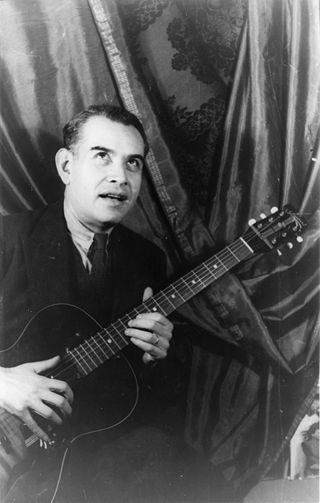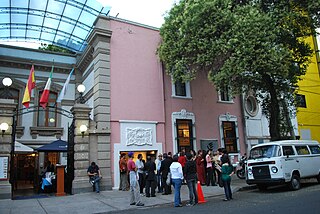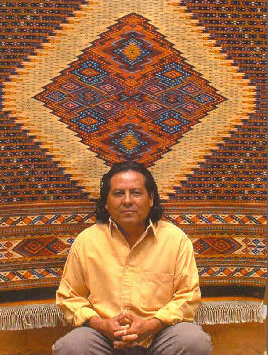
Lithography is a planographic method of printing originally based on the immiscibility of oil and water. The printing is from a stone or a metal plate with a smooth surface. It was invented in 1796 by the German author and actor Alois Senefelder and was initially used mostly for musical scores and maps. Lithography can be used to print text or images onto paper or other suitable material. A lithograph is something printed by lithography, but this term is only used for fine art prints and some other, mostly older, types of printed matter, not for those made by modern commercial lithography.

Rufino del Carmen Arellanes Tamayo was a Mexican painter of Zapotec heritage, born in Oaxaca de Juárez, Mexico. Tamayo was active in the mid-20th century in Mexico and New York, painting figurative abstraction with surrealist influences.
The Taller de Gráfica Popular is an artist's print collective founded in Mexico in 1937 by artists Leopoldo Méndez, Pablo O'Higgins, and Luis Arenal. The collective was primarily concerned with using art to advance revolutionary social causes. The print shop became a base of political activity and abundant artistic output, and attracted many foreign artists as collaborators.

Luis Arenal Bastar was a Mexican painter, engraver and sculptor. He was a founding member of the Liga de Escritores y Artistas Revolucionarios, the Taller de Gráfica Popular and the Salón de la Plástica Mexicana. In addition, he created murals and other monumental works in Mexico City and Guerrero.

Salón de la Plástica Mexicana is an institution dedicated to the promotion of Mexican contemporary art. It was established in 1949 to expand the Mexican art market. Its first location was in historic center of the city but today it mostly operates out of a building in Colonia Roma. The institution is run by a membership of almost four hundred recognized artists and holds multiple exhibitions each year. Although it operates autonomously, it is part of the Instituto Nacional de Bellas Artes y Literatura.
Francisco Díaz de León was a Mexican graphic artist, notable for pioneering much of modern Mexican graphic arts. He spent his childhood around books and when he studied art in Mexico City, he specialized in engraving and illustration. He spent his career illustrating books, magazines and more, reviving techniques such as dry point and introducing new techniques and styles such as the use of color and linoleum printing. He was also a noted arts education, directing several schools including the Escuela Mexicana de las Artes del Libro, which he founded. He was a founding member of the Academia de Artes and a member of the Salón de la Plástica Mexicana. In 1969 he received the Premio Nacional de Artes for engraving.
"Abel" Antonio Pujol Jiménez was a Mexican painter and printmaker.

Pablo Esteban O'Higgins was an American-Mexican artist, muralist and illustrator.
Francisco Mora was a Mexican artist of the "Mexican School" of mural painters.

The University of New Mexico Art Museum is an art museum at the University of New Mexico in Albuquerque. The museum's permanent collection includes nearly 30,000 objects, making it the largest collection of fine art in New Mexico.

Mariana Yampolsky was a Mexican-American photographer. A significant figure in 20th-century Mexican photography, she specialized in capturing photos of common people in everyday situations in the rural areas of the country. She was born in the United States, but came to Mexico to study art and never left, becoming a Mexican citizen in 1958. Her career in photography began as a sideline to document travels and work in the arts and politics, but she began showing her photography in the 1960s. From then until her death in 2002, her work was exhibited internationally receiving awards and other recognition both during her lifetime and posthumously.
Ángel Bracho was a Mexican engraver and painter who is best known for his politically themed work associated with the Taller de Gráfica Popular; however he painted a number of notable murals as well. Bracho was from a lower-class family and worked a number of menial jobs before taking night classes for workers at the Escuela Nacional de Artes Plásticas. Even though he had only four years of primary school, he then studied as a full-time student at the university. His art career began working with Diego Rivera on the painting of the Abelardo L. Rodríguez market in Mexico City. He was a founding member of the Taller de Gráfica Popular, making posters that would become characteristic of the group. His graphic design work is simple, clean and fine dealing with themes related to social struggles with farm workers, laborers and Mexican landscapes.

Leopoldo Méndez was one of Mexico's most important graphic artists and one of that country's most important artists from the 20th century. Méndez's work mostly focused on engraving for illustrations and other print work generally connected to his political and social activism. His most influential work was connected to organizations such as the Liga de Escritores y Artistas Revolucionarios and the Taller de Gráfica Popular creating propaganda related to the ideals of the Mexican Revolution and against the rise of Fascism in the 1930s. Despite his importance in 20th-century artistic and political circles, Méndez was a relatively obscure figure during his lifetime. The reasons for this generally relate to the fact that he believed in working collaboratively and anonymously for the good of society rather than for monetary gain and because the socialist and communist themes of his work fell out of favor with later generations. He has received posthumous recognition with a major biography, and scholarship considers him to be the heir to graphic artist José Guadalupe Posada.
Alberto Beltrán García was a Mexican graphic artist and painter known principally for his work with publications such as illustrations and political cartoons but he created a number of murals as well. He was born in the rough neighborhood of Tepito and began drawing for local publishers when he was a teenager. He attended the Escuela Nacional de Artes Plásticas where one of his teachers introduced him to the Taller de Gráfica Popular where he began his career in earnest. From the late 1940s until his death, he work with various publications, mostly newspapers, but he also did book illustrations as well. In his later career, he worked on a number of murals, especially in the state of Veracruz, which he had an affinity for. Despite winning a number of important awards for his work, he is relatively unknown even in Mexico, with collections of his work scattered among a number of institutions.

Adolfo Mexiac was a Mexican graphic artist, known principally for his politically and socially themed work, especially with the Taller de Gráfica Popular and with fellow graphic artist Leopoldo Méndez. He also painted several murals, the most important of which deals with the history of human law at the University of Colima. In 2011, a “national homage” was held for the artist at the Museo de la Estampa in Mexico City.

Vladimir Cora is a Mexican painter and sculptor based in the state of Nayarit, whose work has been recognized by various awards and membership in the Salón de la Plástica Mexicana. He discovered art at age fifteen, after deciding that he could not be a musician. He received training in Tijuana and Mexico City, with his first success in the 1980s. His style has been described as neo-figurative, minimalist and coarse, and he creates his works in series usually related to the apostles, flowers, birds and women, especially those related to Nayarit. He has had over 150 individual exhibitions both in Mexico and abroad and continues to work from his home state.
Roberto Donis was a Mexican painter and art teacher. He began studying art at the Escuela Nacional de Pintura, Escultura y Grabado "La Esmeralda", but unsatisfied with the instruction, helped organize a student strike. It was unsuccessful and rather than return to school, he decided to go to Morelia to teach. Donis’ art career consisted of exhibitions both in Mexico and abroad, including an important exhibition at the Museo de Arte Moderno in Mexico City and accepted as a regular with the prestigious Galería de Arte Mexicano. His teaching career included directorship at the Universidad Autónoma Benito Juárez as well as helping to found the Taller de Artes Plásticas Rufino Tamayo in the city of Oaxaca. He received several recognitions for his work, including membership in the Salón de la Plástica Mexicana.

Arnulfo Mendoza Ruíz was an artist, cultural promotor, and weaver who exhibited his work within Mexico and internationally. Born in Teotitlán del Valle, Oaxaca, a well-known center of Zapotec weaving, he became one of its best-known artisans, recognized as a "Grand Master" by the Fomento cultural Banamex. He also belonged to the founding group of the Taller Rufino Tamayo in Oaxaca, called "The first generation of the Taller Rufino Tamayo" with artists such as Maximino Javier, Alejandro Santiago, Felipe Morales, Filemón Santiago, among others. He worked on the promotion and dissemination of contemporary art and Oaxacan folkart as director of the La Mano Mágica Gallery, together with his ex-wife Mary Jane Gagnier. The gallery and weaving workshop currently directed by his son Gabriel Mendoza Gagnier.
Patricia Mejía Contreras was a Mexican sculptor and graphic artist whose work was recognized with membership in the Salón de la Plástica Mexicana.
Nicola López (1975) is an American contemporary artist known for her drawings, prints, installations and collages.













